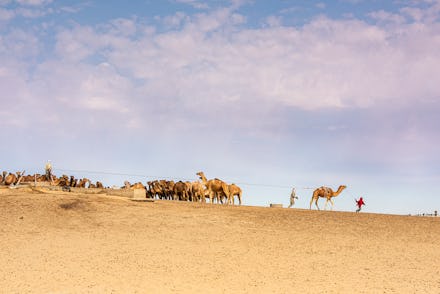Billions could be living in Sahara-like heat within 30 years, new study finds

The Sahara Desert is one of the hottest and driest regions of the planet, experiencing average temperatures of over 100 degrees Farenheit during the day and highs that can reach 136 degrees. It's not surprising, given the extreme heat, that the Sahara has one of the lowest population densities on Earth. Unfortunately, the type of heat that has made the area a less than ideal destination to call home is coming to places where a large chunk of the world's population has already set up shop. According to a study published this week in the Proceedings of the National Academy of Sciences that used modeling to extrapolate out the potential conditions created by human-caused climate change, current greenhouse gas emissions levels could bring Sahara-like heat to billions of people by 2050.
The doomsday scenario painted by researchers of widespread temperature increases is based on the assumption that we continue on our current path without cutting back on carbon emissions. Were emissions to remain at current levels, which would mean that most of the planet is still heavily reliant on fossil fuels for everything from transportation to generating electricity, then as much as 20 percent of the world could experience types of heat that are essentially unbearable for day-to-day life. The estimates project that as many as three billion people, nearly 40 percent of the earth's population, would be affected by the significant uptick in heat and would likely be displaced and forced to seek out more livable conditions, leading to an almost unimaginable climate refugee crisis. Countries including India, Nigeria, Pakistan, Indonesia, Sudan, Niger, the Philippines, Bangladesh, Burkina Faso, and Thailand are all projected to be victims of the rising temperatures.
Humans, like most living creatures, have a preferred "climate niche" or necessary conditions that enable the species to survive. According to researchers, who examined more than 6,000 years of data to see where humans have called home over time, the biggest determining factor for the species is heat. While humans have managed to make due in regions with little rainfall and less than fertile soil, the one thing that they typically cannot abide is severe heat. Most of humankind occupies regions where the average annual temperature remains between 43 and 82 degrees Fahrenheit — with the optimal range more narrowly 51.8 to 59 degrees Fahrenheit. Not only do those conditions typically prove comfortable for people, but they also enable food production through staple crops and livestock. An event like the one warned of in the study would represent a significant shrinking of humanity's climate niche on earth.
If there is good news to be found in the study, it's that our current levels of greenhouse gas emissions are not likely to remain steady. Greenhouse gas emissions leveled off globally last year despite economic growth, suggesting that reliance on fossil fuels might start declining, and the coronavirus pandemic has provided a temporary reprieve from carbon emissions as millions of people shelter in place. However, researchers accounted for recent trends and still project that the unbearable heat will affect more than one billion people by 2070. Prior research has suggested that the planet is actually warming quicker than expected, which does not bode well for people trying to remain within the human climate niche. While much of the temperature rises projected by the latest study will affect Asia and Africa, other regions of the planet are likely to feel the effects, as well. Experts have previously warned that extreme heat could plague more than 250 major cities in the US by 2050, with temperatures climbing above 100 degrees Fahrenheit for at least one month out of the year, if not more. Human activity is quickly starting to shrink the human climate niche, and something has to change before billions of people across the globe are living outside of conditions needed for our survival.